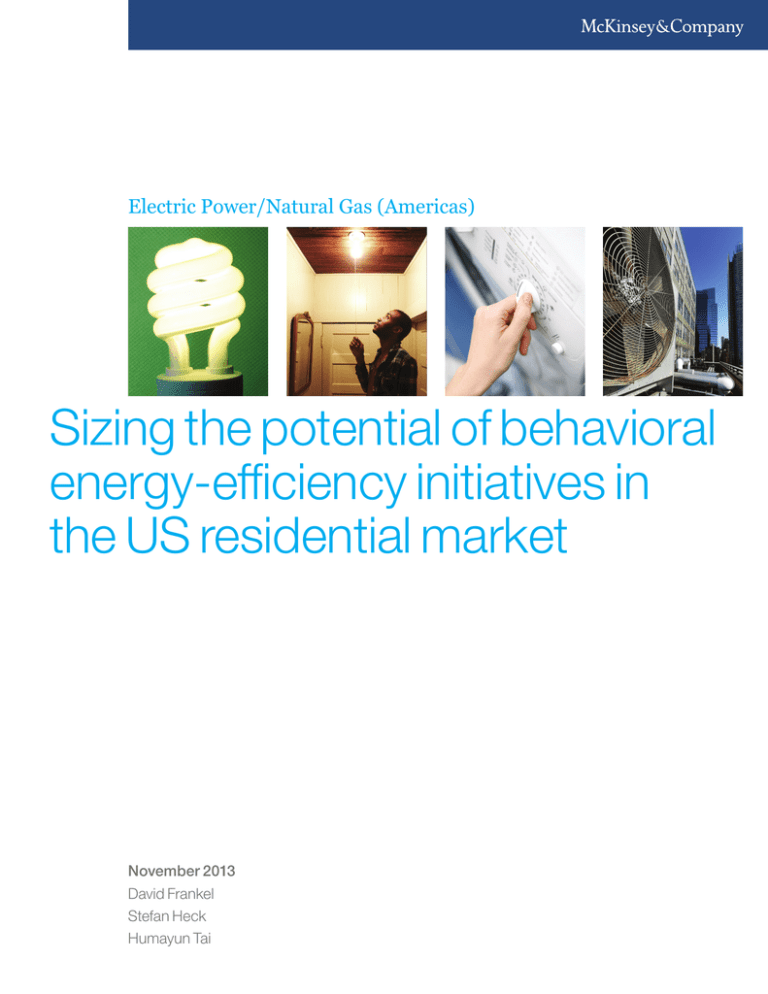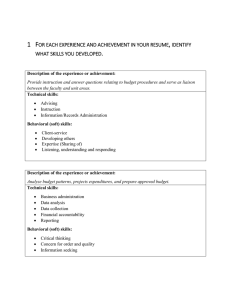Sizing the potential of behavioral energy
advertisement

Electric Power/Natural Gas (Americas) Sizing the potential of behavioral energy-efficiency initiatives in the US residential market November 2013 David Frankel Stefan Heck Humayun Tai 1 Sizing the potential of behavioral energy-efficiency initiatives in the US residential market The US residential sector has become more energy efficient in recent years. Energy savings increased by about 17 percent a year from 2006 to 2011; two important drivers are behind this trend. Utility rate payer-funded spending on energy-efficiency programs has grown at around 21 percent a year, rising to approximately $6.8 billion in 2011 from about $2.6 billion in 2006. Additionally, state governments are pushing for more ambitious energy-efficiency goals and are increasingly adopting regulatory mechanisms to enforce improved residential energy-efficiency performance. To date, most energy-efficiency programs have focused on realizing the potential of technical approaches, which include replacements, upgrades, and modifications of equipment and housing stock. There has been significant progress in making heating, ventilation, and air-conditioning (HVAC) systems and weatherization more efficient and replacing incandescent lighting with compact-fluorescent varieties. However, these programs are becoming saturated, which has led to growing concern about the cost-effectiveness of future energyefficiency efforts (Exhibit 1). Indeed, the avoided energy savings per dollar of program-deployment cost in 2010 had fallen to two-thirds its level in 2000. It is clear that capturing energy efficiency’s full potential will require new approaches. Engaging with consumers to reshape their behavior to reduce energy usage is one way forward. Although some initiatives have been launched to this end, the behavioral energy-efficiency opportunity remains mostly untapped. A breakthrough on the behavioral front, helped by new technology such as smart controls and by social media, could increase the penetration of energy-efficiency products and practices to a majority of households. So, how big is the residential-energy-savings potential that the United States could achieve with limited changes in consumer behavior, and where are the opportunities? What is the size of the energyefficiency prize? A new McKinsey study on consumer behavior identified how residential energy-efficiency performance might benefit from behavioral adjustments that avoid an impact on lifestyle. (See sidebar, “About the research.”) We found that the impact could be immense: an untapped savings opportunity of 1.8 to 2.2 quadrillion British thermal units a year for US households, Exhibit 1 Lighting programs have historically contributed substantial energy savings—but the remaining potential is low. ESTIMATE Lighting programs Program cost Cents per kilowatt-hour Other programs 11 10.1 9.2 10 9 8 7.1 7 6 2.1 5 5.0 1.3 2 1 0.3 0 0 3.5 Screw-in CFLs CFL fixtures 3.0 2.5 1.5 1.0 1.9 0.5 1.0 0 0.1 0.2 0.3 0.4 0.5 0.6 0.7 0.8 0.9 1.0 1.1 NY Specialty CFLs1 2.0 5.8 4 3 Technical potential (California) Terawatt-hour IL MA CA NH IL CA 2013 2014 2015 2016 2017 2018 2019 2020 NY/NH Annual program savings Terawatt-hour On average, lighting programs contribute 66% of energy savings but only 34% of total budget 1 Compact-fluorescent lightbulbs. Source: Navigant report prepared for California Public Utilities Commission, Analysis to Update Energy Efficiency Potential, Goals and Targets for 2013 and Beyond, 2011; utility filings 2 according to our preliminary estimate (Exhibit 2). Such savings would be equivalent to 16 to 20 percent of current US residential-energy demand.1 Examples of behavioral adjustments include turning off lights in unoccupied rooms in a home and switching off central airconditioning systems when no one is at home. Changes that we defined as having an impact on lifestyle—and therefore excluded—include activities such as lowering the lighting level in occupied rooms and reducing heating temperatures in winter to the point that residents would want to wear more clothing. Our results show where the most significant energy-efficiency opportunities are in the residential sector. Heating- and cooling-temperature set points. The largest energy-savings potential, representing 5 to 6 percent of total US residential-energy use, relates to heating-temperature set points in cold weather. Savings related to temperature set points in the summer that could reduce unneeded airconditioning represent a further 2 to 3 percent of energy use. Heating and cooling savings—totaling 7 to 9 percent of residential-energy use—are easy opportunities to unlock through small consumer behavioral changes or through the use of technology, as we will explain in the next section. Hot-water-usage patterns. This is the second-largest opportunity for savings. These savings would represent 4 to 5.4 percent of US residential-energy use and would be driven primarily by reducing hot-water-temperature set points and shortening time spent showering. An additional 1.5 to 2 percent reduction in US residential-energy use could result from actions related to wet-cleaning operations (dishwasher and washer-dryer use)—for instance, using cold instead of hot water, reducing “heated dry” settings on dishwashers, and increasing load size. Again, these measures are relatively simple and entail minimal behavioral changes. Exhibit 2 There is a significant opportunity in ‘nonlifestyle impacting’ behavioral energy efficiency. Behavioral energy-efficiency opportunity for residential customers in the United States % of US nontransportation residential-energy use1 2–3 1.0–1.6 1.5–2.0 0.8–1.5 0.6–1.2 0.5–0.7 16–20 4.0–5.4 5–6 Heat Hot water Airconditioning Fridge Wet cleaning Lighting Media/ electronics Stove Total Potential savings opportunity is 1.8–2.2 quadrillion BTUs2 per year 1 Total US residential-energy use excluding transportation is 11.09 quadrillion British thermal units. 2 British thermal units. Source: 2011 McKinsey survey on energy efficiency in the United States; Annual Energy Outlook; California Energy Commission; Lawrence Berkeley National Laboratory; National Renewable Energy Laboratory; US Department of Energy Residential Energy Consumption Survey 1 See Scott Nyquist et al., Unlocking Energy Efficiency in the US Economy, July 2009 (mckinsey.com), a report prepared in collaboration with 13 leading US-based companies, government agencies, and environmental nongovernmental organizations. The potential savings estimate assumes US residential-energy use of about 11 quadrillion British thermal units a year. Electric Power/Natural Gas (Americas) Sizing the potential of behavioral energy-efficiency initiatives in the US residential market Equipment-usage patterns. Savings potential in lighting (0.8 to 1.5 percent of total US residential-energy use) represents individuals leaving lights on when they are not needed; savings in media and home electronics (0.6 to 1.2 percent of the opportunity) represent both standby power consumption (“vampire load”) and the amount of time devices are on when they are not being used. Technology can provide ways to capture savings in these energy pools. How to capture new energyefficiency savings Based on this analysis, we see a number of approaches to advance energy-efficiency performance in ways that do not have an impact on lifestyle. The untapped potential represents an opportunity for utilities, technology players, policy makers, and consumers. Several approaches, many of them enabled by technology, could be used to support behavioral energyefficiency adoption. We expect that the following could have the greatest impact. Improved home automation. A new generation of sensors and controls for HVAC and lighting make it possible for occupants to more accurately program temperature set points and lighting 3 timetables to reduce energy use. Improved occupancy sensors and controls, for example, can help reduce lighting energy draw. Together, these technologies can help to capture the 7.8 to 10.5 percent potential reduction in residential-energy use across heat, air-conditioning, and lighting indicated in Exhibit 2. Improved management of energy consumption by home electronics. Energy waste in home media and electronics could be reduced by employing improved hardware and software controls and using “smart plugs.” These could help manage home-electronics devices more efficiently and help capture the 0.6 to 1.2 percent potential reduction in residential-energy use, as shown in Exhibit 2. Improved information and feedback to consumers. There is significant potential in behavioral “nudges” that would build on programs already in place and that have shown to be effective. A number of utilities and service companies are offering customers comparisons of their energy use with best-in-class performance in their neighborhoods, leading homeowners to waste less energy. Opportunities exist for utilities and service companies to refine these approaches to further increase impact—including employing sensors, smart metering, and gateway devices to diagnose how consumers use energy, and then tailoring this information to suggest energy-saving approaches. About the research In collaboration with Opower, McKinsey undertook broad primary research on consumer engagement in energy efficiency in the United States. We conducted a number of ethnographic in-home interviews and supplemented this with a 2,500-person national survey to quantify behavioral trends. The survey asked consumers a range of questions related to how they use energy in their homes today. To conduct our analysis, we used survey responses indicating behavior and actions to estimate energy waste. The “optimal” behavior baseline was obtained from research literature, including US Department of Energy Residential Energy Consumption Surveys and industry studies. Energy waste (covering both electricity and gas) was calculated at a household level based on the survey sample, which covered five broad geographic zones across the United States. We offer two caveats about the research. First, results are self-reported and so have inherent inaccuracies; as such, they represent only a rough estimate of the opportunity. Second, the numbers are for the United States overall, but the size of the opportunity will vary significantly by utility, service territory, geography, and customer segment. 4 How important stakeholders should move forward The size of the possible savings from behavioral energyefficiency approaches should encourage stakeholders in the US residential-power sector to consider integrating the approaches into their plans. Here are some pointers about how the field may evolve. Utilities. The key question is how best to engage with consumers to reshape their behavior on energy use. Our research suggests that segmenting consumers based on attitudes and behaviors can open the way to significant improvements in energy-efficiency performance.2 Some utilities now employ only a limited demographic-type segmentation. Utilities should also explore whether behavioral drivers can expand consumer take-up of existing technical-efficiency programs. Additionally, they should study innovative behavior-based programs elsewhere in the industry and see what they can learn. Home-improvement retailers and other players. There is already a quiet explosion in the number of retailers and technology companies seeing a business opportunity in the energy savings that can be unlocked through behavioral approaches and related “asset light” technology. The potentially low barriers to entry make it an attractive segment for these and other participants. However, as the market matures, players could establish leading positions across sectors that include building-automation providers, software start-ups, IT services, combined cable-andtelecommunications providers, and energy retailers. Consumers. Technology and growing awareness of energy efficiency are making it easier for consumers to save energy with little or no impact on their lifestyles. Our research indicates that a significant part of the consumer population is interested in energy efficiency that extends well beyond the green consumer segment. A nuanced approach to customer segmentation could identify opportunities to introduce behavioral programs and related technology offerings. Behavioral measures, combined with innovative technology offerings, could result in overall energy-efficiency savings representing as much as 20 percent of total US residentialenergy consumption. Taking steps to realize this untapped opportunity could significantly reshape the relationship among utilities, other services providers, and their customers over the next few years. 2 For a detailed discussion of new ways to segment the customer base in the residential-power sector, see “Bringing a consumer segmentation approach to advancing energy efficiency in the residential market,” McKinsey & Company, 2013. The authors wish to thank Nikhil Krishnan for his contribution to this article. David Frankel is a consultant in McKinsey’s San Francisco office, and Humayun Tai is a principal in the Atlanta office. Stefan Heck, formerly a McKinsey director, is a senior adviser to the firm. Contact for distribution: Sally Lindsay Phone: +1 (202) 662-0029 E-mail: Sally_Lindsay@mckinsey.com Electric Power/Natural Gas (Americas) November 2013 Designed by Global Editorial Services Copyright © McKinsey & Company


